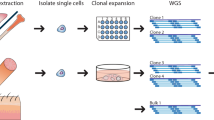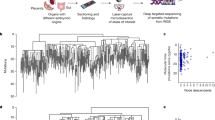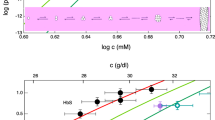Abstract
Halbrecht and Klibanski1 have reported recently that they were able to examine the hæmoglobin of a 10-weeks old human embryo by means of paper electrophoresis. They demonstrated that this hæmoglobin under definite experimental conditions showed an electrophoretic mobility unequivocally slower than the mobility exhibited by adult hæmoglobin. The blood of a 20-weeks old human fœtus was found to contain a hæmoglobin moving identically slowly on paper electrophoretic examination. Moreover, this hæmoglobin showed an electrophoretic mobility which was definitely slower than the mobility of cord hæmoglobin of a full-term newly born. Based on the findings described, the authors suggest that there is a third type of hæmoglobin in early embryonic life besides the two hitherto known normal types of human hæmoglobin, referred to as fœtal hæmoglobin and adult hæmoglobin.
This is a preview of subscription content, access via your institution
Access options
Subscribe to this journal
Receive 51 print issues and online access
$199.00 per year
only $3.90 per issue
Buy this article
- Purchase on Springer Link
- Instant access to full article PDF
Prices may be subject to local taxes which are calculated during checkout
Similar content being viewed by others
References
Halbrecht, J., and Klibanski, C., Nature, 178, 794 (1956).
Drescher, H., and Künzer, W., Klin. Wschr., 32, 92 (1954).
Allison, A., Science, 122, 640 (1955).
Author information
Authors and Affiliations
Rights and permissions
About this article
Cite this article
KÜNZER, W. Human Embryo Hæmoglobins. Nature 179, 477–478 (1957). https://doi.org/10.1038/179477a0
Issue Date:
DOI: https://doi.org/10.1038/179477a0
This article is cited by
-
Das embryonale Hämoglobin (Hb-P)
Klinische Wochenschrift (1966)
-
Human Embryo Hæmoglobin
Nature (1960)
-
Zur Trennung und Gewinnung von fetalem H�moglobin (Hb F) aus Nabelschnurblutfarbstoff mittels Hochspannungselektrophorese
Klinische Wochenschrift (1958)
-
Zur Bestimmung des fetalen H�moglobins mittels Alkalidenaturierung
Klinische Wochenschrift (1957)
Comments
By submitting a comment you agree to abide by our Terms and Community Guidelines. If you find something abusive or that does not comply with our terms or guidelines please flag it as inappropriate.



